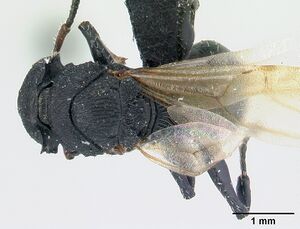Cataulacus wasmanni
| Cataulacus wasmanni | |
|---|---|

| |
| Scientific classification | |
| Kingdom: | Animalia |
| Phylum: | Arthropoda |
| Class: | Insecta |
| Order: | Hymenoptera |
| Family: | Formicidae |
| Subfamily: | Myrmicinae |
| Tribe: | Crematogastrini |
| Genus: | Cataulacus |
| Species: | C. wasmanni |
| Binomial name | |
| Cataulacus wasmanni Forel, 1897 | |
Found in forested habitats, little is known about the biology of Cataulacus wasmanni.
Identification
A member of the huberi group. The description by Forel of the sculpturation and form of the alitrunk seems to ally Cataulacus wasmanni to Cataulacus oberthueri and its allies, particularly to Cataulacus regularis. It should be easily recognizable as it is the only Madagascan species on record in which the direction of sculpturation differs on the propodeum from that on the mesonotum. This arrangement of sculpture is known from two species of the Ethiopian region, namely Cataulacus inermis and Cataulacus pilosus, but in the first of these the propodeum lacks spines, whilst the second is densely hairy. (Bolton 1974)
Keys including this Species
Distribution
Distribution based on Regional Taxon Lists
Malagasy Region: Madagascar (type locality).
Distribution based on AntMaps
Distribution based on AntWeb specimens
Check data from AntWeb
Countries Occupied
| Number of countries occupied by this species based on AntWiki Regional Taxon Lists. In general, fewer countries occupied indicates a narrower range, while more countries indicates a more widespread species. |

|
Estimated Abundance
| Relative abundance based on number of AntMaps records per species (this species within the purple bar). Fewer records (to the left) indicates a less abundant/encountered species while more records (to the right) indicates more abundant/encountered species. |

|
Biology
|
Castes
Worker
Images from AntWeb
   
| |
| Worker. Specimen code casent0498558. Photographer Erin Prado, uploaded by California Academy of Sciences. | Owned by CAS, San Francisco, CA, USA. |
   
| |
| Worker. Specimen code casent0498567. Photographer April Nobile, uploaded by California Academy of Sciences. | Owned by CAS, San Francisco, CA, USA. |
Queen
Images from AntWeb
    
| |
| Queen (alate/dealate). Specimen code casent0498338. Photographer Erin Prado, uploaded by California Academy of Sciences. | Owned by CAS, San Francisco, CA, USA. |
Male
Images from AntWeb
     
| |
| Male (alate). Specimen code casent0498381. Photographer Erin Prado, uploaded by California Academy of Sciences. | Owned by CAS, San Francisco, CA, USA. |
Nomenclature
The following information is derived from Barry Bolton's Online Catalogue of the Ants of the World.
- wasmanni. Cataulacus (Otomyrmex) wasmanni Forel, 1897c: 193 (w.) MADAGASCAR. [Otomyrmex wasmanni Wasmann, 1897: 250. Nomen nudum, attributed to Forel.] See also: Bolton, 1974a: 29.
Unless otherwise noted the text for the remainder of this section is reported from the publication that includes the original description.
Description
Worker
Bolton (1974) - TL 5.3.
Occipital crest developed. Occipital corners with short, fairly small, triangular, ear-shaped points. Eyes very large, fiat. Sides of head behind eyes apparently not denticulate. Preocular tooth present. In profile the dorsal outline of the alitrunk hemispherically arched. Pronotum marginate, not denticulate, the margin sharp, horizontal and leaf-like. Mesonotum and propodeum with a horizontal, broad, short thorn or strong tooth. Promesonotal suture indicated by an impression. Propodeum with a pair of very long, acute, divergent spines, which are half as long as the entire alitrunk. Gaster short, elliptical, almost round in dorsal view.
Head densely and coarsely, regularly longitudinally rugose dorsally. Occipital surface behind the crest transversely rugose. Pronotum coarsely, densely longitudinally striate; the mesonotum similarly but very regularly striate. Propodeal dorsum transversely striate, the sides longitudinally so; similarly the segments of the pedicel. Gaster reticulate-punctate with fine but not dense longitudinal striation. Hairs absent from the dorsal surfaces of the head and body, present on the appendages, the anterior portion of the head and mandibles, and the gastral apex.
Type Material
Bolton (1974) - Holotype worker, MADAGASCAR: Isle Ste. Marie, Kalalo (location of type not known). I have not been able to locate the type of this species.
References
- Bolton, B. 1974a. A revision of the Palaeotropical arboreal ant genus Cataulacus F. Smith (Hymenoptera: Formicidae). Bull. Br. Mus. (Nat. Hist.) Entomol. 30:1-105. (page 29, see also)
- Forel, A. 1897d. Ameisen aus Nossi-Bé, Majunga, Juan de Nova (Madagaskar), den Aldabra-Inseln und Sansibar, gesammelt von Herrn Dr. A. Voeltzkow aus Berlin. Mit einem Anhang über die von Herrn Privatdocenten Dr. A. Brauer in Marburg auf den Seychellen un (page 193, worker described)
References based on Global Ant Biodiversity Informatics
- Bolton B. 1974. A revision of the Palaeotropical arboreal ant genus Cataulacus F. Smith (Hymenoptera: Formicidae). Bulletin of the British Museum (Natural History). Entomology 30: 1-105.
- Fisher B. L. 1997. Biogeography and ecology of the ant fauna of Madagascar (Hymenoptera: Formicidae). Journal of Natural History 31: 269-302.
- Fisher B. L. 2003. Formicidae, ants. Pp. 811-819 in: Goodman, S. M.; Benstead, J. P. (eds.) 2003. The natural history of Madagascar. Chicago: University of Chicago Press, xxi + 1709 pp.
- Forel A. 1897. Ameisen aus Nossi-Bé, Majunga, Juan de Nova (Madagaskar), den Aldabra-Inseln und Sansibar, gesammelt von Herrn Dr. A. Voeltzkow aus Berlin. Mit einem Anhang über die von Herrn Privatdocenten Dr. A. Brauer in Marburg auf den Seychellen und von Herrn Perrot auf Ste. Marie (Madagaskar) gesammelten Ameisen. Abhandlungen der Senckenbergischen Naturforschenden Gesellschaft 21: 185-208.
- Wheeler W. M. 1922. Ants of the American Museum Congo expedition. A contribution to the myrmecology of Africa. IX. A synonymic list of the ants of the Malagasy region. Bulletin of the American Museum of Natural History 45: 1005-1055



